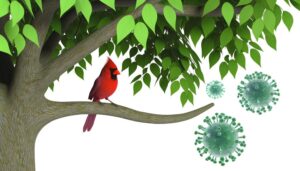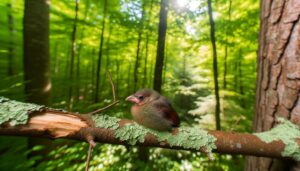Essential Tips to Take Care of Cardinal Birds
To care for Cardinalis cardinalis, provide a suitable environment with dense shrubbery and bird-friendly plants like Dogwood and Sunflowers. Offer high-fat seeds such as black oil sunflower and safflower seeds, along with fruits like berries.
Utilize platform feeders with stable perches placed 5-6 feet high in sheltered areas. Maintain fresh water in shallow birdbaths, especially in cold climates.
Regularly monitor their health for parasites and plumage conditions. Protect them from predators using dense vegetation and predator-proof feeders.
Seasonally adjust diet and habitat to their changing needs. Implement these practices to ensure a thriving cardinal presence.

Key Takeaways
- Provide a diet of black oil sunflower seeds, safflower seeds, fruits, and insects.
- Position feeders in quiet, sheltered areas, preferably near dense shrubbery or trees.
- Ensure a clean, fresh water source, ideally in shallow birdbaths, and change water regularly.
- Offer shelters made from untreated wood, placed at moderate heights, and away from domestic animals.
- Regularly clean feeders and monitor cardinal health for parasites and abnormal behaviors.
Understanding Cardinals
Cardinals, scientifically known as Cardinalis cardinalis, are robust mid-sized songbirds renowned for their vibrant red plumage in males and their melodic songs. In contrast, females exhibit a more subdued coloration, featuring brownish tones with reddish accents.
These birds inhabit woodlands, gardens, and shrublands across North and Central America, displaying a preference for dense foliage. Their diet primarily consists of seeds, fruits, and insects, requiring a habitat rich in these resources.
Cardinals exhibit strong territorial behavior, particularly during breeding seasons, which span from March to September. They construct cup-shaped nests using twigs, leaves, and grasses, often positioned within dense shrubs.
Understanding these ecological and behavioral characteristics is essential for ensuring their effective care and conservation in both natural and controlled environments.
Attracting Cardinals
Attracting cardinals to your yard involves strategic feeder placement and specific food preferences. Position feeders in quiet, sheltered areas to provide a sense of security while ensuring they are visible to the birds.
Offering a diet rich in sunflower seeds, safflower seeds, and crushed peanuts will cater to their nutritional needs and increase the likelihood of frequent visits.
Ideal Feeder Placement
To effectively attract cardinal birds, it is crucial to strategically place feeders in locations that offer both safety and an abundant food supply. Cardinals prefer feeders positioned near dense shrubs or trees, which provide cover from predators and harsh weather.
Ideal feeder height is approximately 5-6 feet above the ground, minimizing ground predator threats while allowing easy access. Additionally, placing feeders away from high-traffic areas reduces disturbances, promoting frequent visits.
Guarantee feeders are in open, visible locations to facilitate easy discovery by the birds. Regularly monitor and adjust feeder positions based on cardinal activity and environmental changes. By carefully considering these factors, one can create an excellent feeding environment that appeals to and supports the well-being of cardinal birds.
Food Preferences
Understanding the specific dietary preferences of cardinal birds is essential for effectively attracting them to your feeders. Cardinals primarily consume seeds, with a marked preference for sunflower seeds, particularly black oil sunflower seeds due to their high oil content and ease of cracking.
They also favor safflower seeds, which are less attractive to other bird species, thereby reducing competition. In addition to seeds, cardinals enjoy consuming berries, fruits, and insects, providing them with a varied diet that supports their nutritional needs.
To attract cardinals, it is advisable to offer a mix of these foods in a sturdy feeder. Ensuring a consistent food supply, especially during winter months, can notably increase the likelihood of cardinals frequenting your garden.
Choosing Bird Feeders
Selecting the appropriate bird feeder is essential for attracting and supporting cardinal populations. Various feeder types, such as platform feeders and tube feeders with large perches, cater to the physical characteristics and feeding behaviors of cardinals.
Additionally, strategic placement of feeders in safe, accessible locations can greatly enhance the likelihood of regular visits from these vibrant birds.
Feeder Types
When selecting appropriate bird feeders for cardinals, it is important to take into account specific designs that accommodate their feeding habits and physical characteristics. Cardinals prefer feeders that provide stable perches and are spacious enough to accommodate their relatively large size. Suitable feeder types include platform feeders, hopper feeders, and tube feeders with large perches. Each feeder type offers unique benefits that cater to cardinal preferences and can be summarized as follows:
| Feeder Type | Benefits | Considerations |
|---|---|---|
| Platform Feeders | Spacious, accommodates multiple birds | Requires regular cleaning |
| Hopper Feeders | Protects seed from elements | May require stronger mounting |
| Tube Feeders | Large perches for cardinals | Ensure perch width is adequate |
| Window Feeders | Close-up birdwatching | Limited to smaller groups |
This understanding ensures best feeder selection for cardinal welfare.
Placement Tips
Proper placement of bird feeders is crucial to maximizing the attraction of cardinals and guaranteeing their safety and comfort. Position feeders at a height of 5 to 6 feet above the ground to deter predators.
Choose locations near dense shrubbery or trees, as these provide essential cover and perching spots for cardinals.
Make sure feeders are away from windows to prevent collisions, ideally at least 10 feet away or within 3 feet to minimize impact. Additionally, place feeders in areas sheltered from strong winds and direct sunlight to maintain a stable food supply.
Regularly check and clean feeding stations to prevent the spread of disease, optimizing the environment for cardinal visitation and health.
Best Foods for Cardinals
Cardinals thrive on a diet that includes a variety of seeds, fruits, and insects, each providing necessary nutrients for their health and vibrant plumage. High-quality seeds such as black oil sunflower seeds and safflower seeds are particularly favored due to their rich fat content, which supports energy needs.
Fruits like berries, apples, and grapes supply essential vitamins and antioxidants, enhancing immune function. Additionally, insects such as beetles, caterpillars, and grasshoppers offer key proteins and micronutrients, important during breeding seasons.
Incorporating these dietary components guarantees a balanced intake of proteins, fats, and carbohydrates, promoting overall well-being. Supplementing with specialized cardinal bird food mixes can also provide a detailed nutritional profile tailored to their specific dietary requirements.
Water Sources
In addition to a well-rounded diet, providing access to clean, fresh water is essential for maintaining the health and energy of cardinals.
Water sources should be shallow, as cardinals prefer to drink and bathe in water that is no more than two inches deep. Birdbaths made from materials like ceramic or stone are ideal as they retain temperature and are easy to clean.
Guarantee the water is changed regularly to prevent bacterial growth and mosquito breeding. Additionally, placing the birdbath in a shaded area helps keep the water cool and reduces evaporation.
In colder climates, consider using a heated birdbath to prevent freezing, ensuring year-round access to water for these resilient birds.
Nesting Sites
When selecting nesting sites, cardinal birds exhibit a preference for dense shrubbery and thick foliage, which provide both protection from predators and a stable environment for raising their young. These sites are typically located at a height of 1-15 feet off the ground, often within bushes, trees, or tangles of vines.
Cardinals favor areas with an abundance of leaves and branches, ensuring concealment and structural support for their nests. The nest itself is usually built using twigs, bark strips, and grasses, forming a sturdy, cup-like structure. Females mainly choose the nesting location and construct the nest, with males assisting by providing materials.
Understanding these preferences can aid in creating a conducive environment for cardinal nesting.
Safe Shelter
Providing a safe shelter is crucial to safeguarding the well-being of cardinal birds, as it significantly reduces their vulnerability to predators and harsh weather conditions. Cardinals prefer dense vegetation for roosting, which offers protection and seclusion.
Consider placing birdhouses or natural shelters like thick shrubs and hedges in your garden. These structures should be positioned at a moderate height, ideally 4-6 feet above ground, to deter ground predators. Additionally, avoid placing shelters near locations frequented by domestic animals.
Opt for materials that withstand weather extremes, such as untreated wood, to prevent harmful chemical exposure. Make sure that the shelter is adequately ventilated to prevent overheating during warmer months and insulated to provide warmth during colder seasons.
Planting for Cardinals
Strategically choosing indigenous plants that yield berries and seeds can significantly boost the habitat for cardinal birds, fostering their nutritional needs and overall well-being. These plants not only provide essential food sources but also establish an environment favorable for nesting and protection from predators.
| Plant Type | Benefits to Cardinals |
|---|---|
| Dogwood | Provides berries rich in carbohydrates |
| Sunflower | Seeds are a high-energy food source |
| Serviceberry | Offers nutritious berries and shelter |
| Eastern Red Cedar | Produces berries and dense nesting sites |
Selecting a variety of these plants guarantees a steady food supply throughout the year, meeting the dietary requirements of cardinals. Additionally, the integration of diverse plant species supports the ecological balance, benefiting both the birds and the broader environment.
Seasonal Care Tips
To secure the well-being of cardinal birds throughout the year, it is important to adapt care practices to the specific needs and challenges of each season.
During winter, provide high-energy foods like sunflower seeds and suet to support their increased metabolic demands. Ensure a consistent water source, as natural sources may freeze.
In spring, focus on nesting sites by offering dense shrubs and safe nesting materials.
Summer care involves maintaining hydration with fresh water and providing shade to prevent overheating.
Autumn requires preparation for winter; stock feeders with nutrient-rich seeds to build energy reserves.
Each season presents unique requirements, necessitating specific adjustments to habitat and diet to support the health and longevity of cardinal birds.
Health Monitoring
Regular health monitoring of cardinal birds is important for early detection of diseases and maintaining their overall well-being. Observing changes in behavior, such as lethargy or altered eating patterns, can provide early indicators of health issues.
Routine examinations should include checking for external parasites like mites and ticks, as well as inspecting the bird's plumage for signs of feather loss or abnormalities. Additionally, monitoring the bird's droppings can reveal potential gastrointestinal problems.
Weight checks are critical; unexplained weight loss or gain can indicate underlying health concerns. Implementing a balanced diet rich in seeds, fruits, and insects ensures optimal nutrition.
Lastly, maintaining a clean habitat reduces the risk of infections and promotes a healthy living environment for these vibrant birds.
Protecting From Predators
In addition to health monitoring, safeguarding cardinal birds from predators is essential for their survival and well-being. Effective methods include providing dense shrubbery and evergreen trees, which offer concealment and nesting sites.
Utilizing predator-proof feeders can minimize risk from domestic cats, hawks, and other threats. Installing baffles on feeder poles helps deter climbing predators. Additionally, placing feeders away from potential ambush sites such as thick bushes can reduce predation risk.
Motion-activated lights and ultrasonic repellers may also be employed to discourage nocturnal predators. Ensuring a clean environment and promptly removing fallen seeds can prevent attracting unwanted animals.
Implementing these strategies can greatly enhance the safety of cardinal birds, fostering a secure habitat conducive to their thriving.
Conclusion
To sum up, the diligent care of cardinal birds involves a meticulous understanding of their habitat preferences, dietary needs, and seasonal behaviors.
Employing scientifically backed strategies, such as selecting best-suited feeders and providing appropriate plantings, helps these vibrant avians thrive.
Ironically, while humans exert considerable effort to attract and sustain these birds, cardinals, in their majestic simplicity, continue to survive and flourish in natural settings, seemingly indifferent to the intricacies of human intervention.






